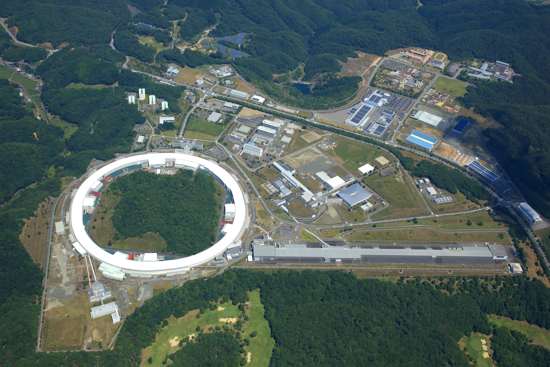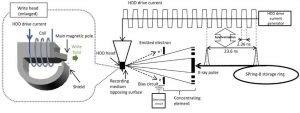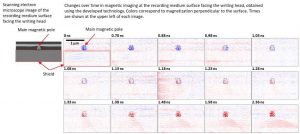Toshiba’s Analysis Technology for HDD Write Head World’s First to Image Dynamics of Write Head With Precision of One Ten-Billionth of Second
R&D from Toshiba, Japan Synchrotron Radiation Research Institute and Tohoku University will contribute to increased HDD capacities.
This is a Press Release edited by StorageNewsletter.com on January 15, 2021 at 2:11 pmUsing synchrotron radiation (1) at Spring-8 (2), large-scale synchrotron radiation facility, Toshiba Corporation, the Japan Synchrotron Radiation Research Institute (JASRI), and Tohoku University have succeeded in imaging the magnetization dynamics of a HDD write head (3) for the first time ever, with a precision of one ten-billionth of a second.
Bird’s eye view of the SPring-8.
(Courtesy: RIKEN)
The method makes possible highly precise analysis of write head operations, and will accelerate the development of the next-generation write head and further increase in HDD capacity.
Details of the research (4) was published in the Journal of Applied Physics on October 6 and was presented in the 44th Annual Conference on Magnetics in Japan, on December 14.
IDC predicts a five-fold increase in the volume of data generated WW in the 7 years between 2018 and 2025, an immense increase. HDDs continue to serve as the primary data storage devices in use, and in 2020 the annual total capacity of shipped HDDs is expected to exceed 1ZB, with sales reaching $20 billion (5). Securing further increases in HDD capacity and higher data transfer rates with logical write head designs requires a highly detailed and accurate understanding of write head operations. There are, however, high barriers to achieving this: current write head have a very fine structure, with dimensions of less than 100 nanometers (6), and magnetization reversal occurs in less than a nanosecond, rendering experimental observations of write head dynamics very difficult. Instead, the write head analysis has been conducted by simulations of magnetization dynamics, or done indirectly by evaluating the write performance on the magnetic recording media. Both approaches have their drawbacks, and there is clear demand for a new method capable of precisely capturing the dynamics of a write head.
Overview of developed analysis technology.
Toshiba, JASRI and Tohoku University have used the scanning soft X-ray magnetic circular dichroism microscope (7) installed on the BL25SU beamline at SPring-8, a large-scale synchrotron radiation facility, to develop a new analysis technology for the HDD write head. This realizes time-resolved measurements through synchronized timing control, in which a write head is operated at an interval of one-tenth of the cycle of the periodic X-ray pulses generated from the SPring-8 storage ring. Simultaneously, focused X-rays scan the medium-facing surface of a write head, and magnetic circular dichroism imaged temporal changes in the magnetization. This achieves temporal resolution of 50 picoseconds (8) and spatial resolution of 100 nanometers (9), enabling analyses of the fine structures and fast write head operation. This method has the potential to achieve even higher resolutions i.e. by improving the focusing optics for the X-rays.
Changes in magnetization at write head
Toshiba is currently developing energy-assisted magnetic recording technologies
for next-generation HDD and aims to apply the developed analysis method
and the knowledge obtained about write head operations to the development
of a write head for energy-assisted magnetic recording.
The development team used the new method to obtain the time evolution of the magnetization images during reversal of the write head. The imaging revealed that magnetization reversal of the main pole IS completed within a nanosecond and that spatial patterns from magnetization appear in the shield area in response to the main pole reversal. No previous research into write head operations write has achieved such high spatial and temporal resolutions, and use of this approach is expected to support high-precision analyses of write head operations, contributing to the development of the next-generation write head and to the further improvements in HDD performance.
Paper information
Title: Time-resolved imaging of an operating hard-disk-drive write head using nano-beam x-ray magnetic circular dichroism
Authors: H. Suto, A. Kikitsu, Y. Kotani, T. Maeda, K. Toyoki, H. Osawa, N. Kikuchi, S. Okamoto and T. Nakamura
Journal: Journal of Applied Physics 128, 133903 (2020), DOI:doi.org/10.1063/5.0022571
Glossary:
(1) Synchrotron radiation facility Spring-8: A RIKEN facility at the Harima Science Garden City in Hyogo prefecture that produces the world’s highest performance synchrotron radiation. JASRI provides support for its use. ‘SPring-8’ is an abbreviation for ‘Super Photon ring-8 GeV.’ SPring-8 applies synchrotron radiation in a wide range of research fields, including nanotechnology, biotechnology, and industrial applications.
(2) Synchrotron radiation: A narrow, powerful electromagnetic beam generated by accelerating electrons to near the speed of light and bending their paths with magnets. Synchrotron radiation beams are extremely bright, tightly focused and resistant to spreading, include a wide range of wavelengths from X-rays to infrared, are polarized, and are emitted as repeated short pulses.
(3) Write head: In an HDD, a write head generates a localized magnetic field (a write field) that performs digital recording on a magnetic recording medium. The recording density and data transfer rate of an HDD depends on the write field distribution and operation speed.
(4) Results of this research: Published on 6 October in the online edition of the Journal of Applied Physics, an academic journal published by the American Institute of Physics: doi.org/10.1063/5.0022571
(5) Source: IDEMA Japan January 2020 Seminar Report.
(6) Nano: 1/1,000,000,000 (one-billionth).
(7) Scanning soft X-ray magnetic circular dichroism microscope ‘X-ray magnetic circular dichroism’ is a phenomenon in which the absorption coefficient of circularly polarized X-rays in a magnetic material differs between left and right circular polarization. A scanning soft X-ray magnetic circular dichroism microscope uses focused soft X-rays from a light source. By scanning X-rays in two dimensions and by measuring differences in absorption between left and right circular polarization, nanoscale magnetization is examined with extremely high sensitivity. This apparatus was developed as part of the Ministry of Education, Culture, Sports, Science and Technology’s ‘Element Strategy Initiative: To Form Core Research Centers’ project.
(8) Temporal resolution of 50 picoseconds: Meaning changes over time were captured at intervals of 1/20,000,000,000th (one twenty-billionth) of a second.
(9) Spatial resolution of 100 nanometers: Meaning different points separated by only 100 nanometers could be distinguished.
Article:Time-resolved imaging of an operating hard-disk-drive write head using nano-beam x-ray magnetic circular dichroism
Journal of Applied Physics has published an article written by Hirofumi Suto, Akira Kikitsu, Corporate Research and Development Center, Toshiba Corporation, Kawasaki 212-8582, Japan, Yoshinori Kotani, Japan Synchrotron Radiation Research Institute, Sayo 679-5198, Japan, Tomoyuki Maeda, Corporate Research and Development Center, Toshiba Corporation, Kawasaki 212-8582, Japan, Kentaro Toyoki, Hitoshi Osawa, Japan Synchrotron Radiation Research Institute, Sayo 679-5198, Japan, Nobuaki Kikuchi, Satoshi Okamoto, Institute of Multidisciplinary Research for Advanced Materials, Tohoku University, Sendai 980-8577, Japan, and Center for Spintronics Research Network, Tohoku University, Sendai 980-8577, Japan, and Tetsuya Nakamura, Japan Synchrotron Radiation Research Institute, Sayo 679-5198, Japan.
Abstract: “We studied the dynamic magnetization behavior of a hard-disk-drive (HDD) write head by using nano-beam x-ray magnetic circular dichroism (XMCD). The write head was operated by applying a square-wave write current with a frequency of 211.9 MHz to the coil of the write head, which was in synchronization with the fivefold frequency of the x-ray pulses. Snapshot images of the magnetization on the air-bearing surface of the write head were obtained with spatial and time resolutions of 100 nm and 50 ps, respectively, and temporal changes in the magnetization of the main pole and the shield were observed. When a square-wave write current with a transition time of 0.2 ns was applied, the magnetization reversal of the main pole was completed in 0.7 ns, and this reversal time was determined by the dynamic property of the write head. During the main pole reversal, the shield area showed spatially non-uniform magnetization patterns, and its response was slower than that of the main pole. These results show that the XMCD measurement setup developed in this study is a powerful tool for understanding the dynamic behavior of an HDD write head and contributes to the development of higher capacity HDDs. “
Acknowledgments:
The x-ray measurements were performed at BL25SU of SPring-8 with the approval of the Japan Synchrotron Radiation Research Institute (JASRI) (Proposal Nos. 2018A1109, 2019B1683, and 2019B2093). The scanning soft XMCD microspectroscopy technique was developed under the Elements Strategy Initiative Center for Magnetic Materials (ESICMM), Grant No. JPMXP0112101004, through the Ministry of Education, Culture, Sports, Science and Technology (MEXT).

















 Subscribe to our free daily newsletter
Subscribe to our free daily newsletter

